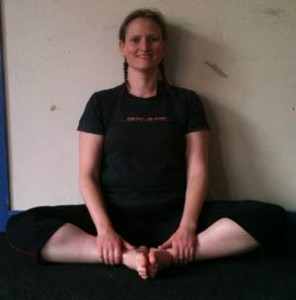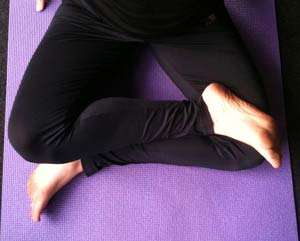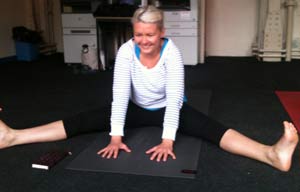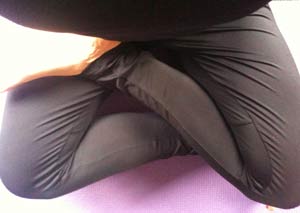Most of us have tight hips, mostly because we spend so much of our time sitting in chairs. At my recent hip opening workshop we discussed how the benefits of opening your hips expand beyond your ability to do lotus pose. Having freedom of movement in your hips is so important for posture, especially as it is so close to the centre of your body. Lotus often features in images of the yogi and as such this posture has become a goal for many. That’s fine but remember to accept and enjoy where you are right now too. You also need to respect your body whilst attempting lotus and follow the guidelines of Patanjali ahimsa (non-violence). Be particularly careful about your knees, if your hips are not open enough then your knees may try and help out, this is not their job. If you ever feel even a little bit of discomfort in your knees doing lotus, come out of it, even if you can usually do it. Seriously, you only get one set of knees look after them. Regular practice of the primary series of ashtanga yoga will do wonders for your hip mobility.
My journey to lotus
About six or seven years ago, I was struggling with many of the lotus based poses in ashtanga yoga. I was practicing ashtanga yoga daily and it was coming slowly but I decided to do some additional yin yoga. As I was going to a lot of yoga classes most evenings at the time and working as a school teacher, I decided to do this practice in the morning before work. It was a lovely way to start the day. It gave me some space which I am sure made me a better teacher and I walked to the bus stop with much freer hips and a smile on my face.
What is Yin yoga
In yin yoga, you hold the positions for a longer period of time about 5-10 minutes. It’s almost the opposite of ashtanga yoga, which is much more fluid coming in and out of the poses. The idea behind yin is that it helps to release the fascia. Fascia is the interconnecting tissue between your muscles. I found yin yoga worked particularly well in opening my hips.
The morning hip opening yin yoga sequence
The great thing about this sequence is that it is highly adaptable. Each position is help for 5-10 minutes so if you have 15 minutes, you know you can do 3 poses for 5 minutes each. You can do this as an asana practice or you can do it when your doing other things, like reading. If you already have a yoga practice, then I think that’s fair enough. Obviously there will be more benefit to doing a focused practice but do what works for you.
Baddha Konasana – bound angle pose

You can hold this pose for 5 to 10 minutes but start with five and build up. Place your back up against the wall. I used to have my breakfast like this in the morning. If one side is tighter than the other then prop the more flexible side up, otherwise the tight side doesn’t get as much of a stretch. A pair of socks works well for this but use whatever you have handy and put under the more flexible hip.
Made upasana (lol)
 This is a variation that I teach for Marichyasana B, for people who can’t do half lotus. It is great for opening your hips. It releases the piriformis, which if tight can be one of the causes of sciatic pain. As this muscle connects the upper and lower body, it is important to keep it relaxed. Sitting on chairs tightens it and if you want open your lotus, this will really help you. Place your right foot over your left just above the knee, then place your back against the wall, gradually bend your left leg until you feel a stretch in your right hip. If you are very tight or are having problems with your back, I recommend you do this instead for 30 seconds to a minute. You can hold this yin variation for 5 minutes, repeat on the other side.
This is a variation that I teach for Marichyasana B, for people who can’t do half lotus. It is great for opening your hips. It releases the piriformis, which if tight can be one of the causes of sciatic pain. As this muscle connects the upper and lower body, it is important to keep it relaxed. Sitting on chairs tightens it and if you want open your lotus, this will really help you. Place your right foot over your left just above the knee, then place your back against the wall, gradually bend your left leg until you feel a stretch in your right hip. If you are very tight or are having problems with your back, I recommend you do this instead for 30 seconds to a minute. You can hold this yin variation for 5 minutes, repeat on the other side.
So there’s a 15- 20 minute sequence….
Agnistambhasana – fire log pose or double pigeon
 Want more? Try fire log pose also known as double pigeon and or half lotus with the other leg in pigeon. In the first variation stack your shins on top of each other and lean forward gently.
Want more? Try fire log pose also known as double pigeon and or half lotus with the other leg in pigeon. In the first variation stack your shins on top of each other and lean forward gently.
For half lotus pigeon place one leg carefully place one leg in half lotus and place the other foot under your knee. Hold each pose for 5 minutes and be sure to do both sides.
Upavashta Konasana – seated angle pose
 If you have more time, then upavishta konasana is a key pose which works great as a yin pose. This is a great pose for opening your adductors (inner thigh) and will help free your hips. Find a way of being comfortable here, don’t overstretch. If you feel pain in any of these positions back off and talk to your yoga teacher. This post can’t replace the advice of an actual teacher who can see and adapt these poses to suit your needs. If I am that teacher, hopefully you already know I welcome questions.
If you have more time, then upavishta konasana is a key pose which works great as a yin pose. This is a great pose for opening your adductors (inner thigh) and will help free your hips. Find a way of being comfortable here, don’t overstretch. If you feel pain in any of these positions back off and talk to your yoga teacher. This post can’t replace the advice of an actual teacher who can see and adapt these poses to suit your needs. If I am that teacher, hopefully you already know I welcome questions.
At the end of your practice, gently see if you can do lotus, listen to your body and ignore your ego, repeat….
Would like to thank my students Matylda, Rosey and Gabor for allowing me to use their photos and Joana for her photography help :-). This post was requested at my recent hip opening workshop if you have something you would like me to write about, please contact me.
My next workshop in September will be more about hip openers and yin yoga. Details will be on my website in July. If you want to keep updated subscribe to my newsletter.
Do you do any extra poses, outside of your ashtanga practice? I won’t tell the Ashtanga police honest ;-).

